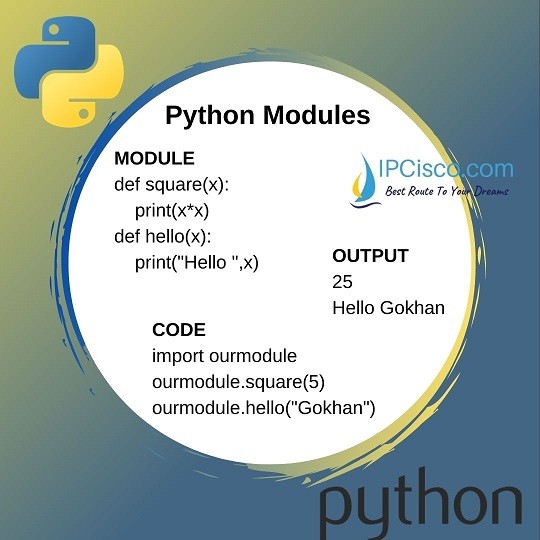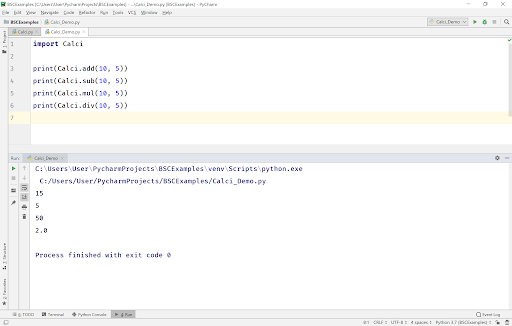How to create a module in Python
How to create a module in Python

Creating a module in Python is a fundamental concept that allows you to organize your code into reusable pieces of functionality. A Python module is essentially a single file that contains a collection of related functions, classes, and variables. Here's how to create a module in Python:

Step 1: Choose a File Name
Choose a unique and meaningful name for your module, following the standard naming conventions (e.g., module_name.py). This will be the name of the file containing your code.
Step 2: Write Your Code
In your chosen file, write your Python code, which can include functions, classes, variables, and even other modules. Each module is a separate entity that can have its own imports, class definitions, and function definitions.
Step 3: Use Import Statement
To use the functions or classes from your module in another part of your program, you need to import them using the import statement. You can either import specific objects (functions, classes) using the dot notation (e.g., from mymodule import my_function) or import the entire module itself (e.g., import mymodule). The latter allows you to access all the contents of your module.
Step 4: Organize Your Code
Modules provide a way to organize your code into logical groups. You can create subdirectories and place related modules within them. This helps keep your codebase structured, making it easier to maintain and update individual components.
Here's an example of a simple Python module:
# mymodule.pydef greet(name):
print(f"Hello, {name}!")
class Person:
def init(self, name):
self.name = name
def say_hello(self):
print(f"Hi, I'm {self.name}!")
To use this module in another part of your program:
# main.pyimport mymodule
def main():
mymodule.greet("John")
person = mymodule.Person("Jane")
person.say_hello()
if name == "main":
main()
In this example, we have a mymodule containing two functions (greet) and a class (Person). In the main.py file, we import the entire mymodule and use its contents to greet someone and create a person object.
Tips and Best Practices
Keep your module's contents concise and focused on specific tasks. Use meaningful names for your modules, functions, and variables. Document your code with docstrings (comments) to help others understand what each part does. Test your code thoroughly before distributing or using it in production.Creating a Python module is just the beginning. As you continue to develop and refine your code, you'll find that modules become an essential building block for constructing robust, maintainable programs.
Built-in modules in Python
Built-in modules are a fundamental part of the Python programming language, providing essential functionalities that can be leveraged to create robust and efficient programs. In this response, I will discuss some of the most commonly used built-in modules in Python, highlighting their key features, uses, and examples.
math: The math module provides mathematical functions for tasks such as trigonometry, exponentiation, and logarithms. This module is particularly useful when dealing with numerical computations or data analysis.
Example:
import mathprint(math.sin(3.14)) # prints the sine of 3.14
print(math.pow(2, 3)) # prints 8 (2 raised to the power of 3)
statistics: The statistics module provides functions for calculating statistical measures like mean, median, mode, and standard deviation.
Example:
import statisticsdata = [1, 2, 3, 4, 5]
print(statistics.mean(data)) # prints the mean of the data set
random: The random module provides functions for generating random numbers or selecting random elements from a list.
Example:
import randomdata = [1, 2, 3, 4, 5]
print(random.choice(data)) # selects a random element from the data set
time: The time module provides functions for working with dates and times, such as calculating elapsed time or converting between formats.
Example:
import timestart_time = time.time()
perform some operationsend_time = time.time()
print(end_time - start_time) # prints the elapsed time in seconds
re: The re (regular expression) module provides functions for pattern matching and string manipulation using regular expressions.
Example:
import repattern = r'd+'
text = 'Hello, my phone number is 123-456-7890.'
match = re.search(pattern, text)
print(match.group()) # prints the matched substring (the phone number)
itertools: The itertools module provides functions for working with iterators and iterable objects, such as combining, partitioning, or grouping elements.
Example:
import itertoolsdata = [1, 2, 3, 4, 5]
print(list(itertools.groupby(data))) # groups the data by consecutive equal elements
functools: The functools module provides functions for working with higher-order functions (functions that take or return other functions) and partial application of functions.
Example:
import functoolsdef add(a, b):
return a + b
add_twice = functools.partial(add, 2)
print(add_twice(3)) # prints 5 (equivalent to calling add with the first argument set to 2)
collections: The collections module provides functions for working with data structures like dictionaries, sets, and lists.
Example:
import collectionsdata = {'a': 1, 'b': 2}
print(collections.Counter(data)) # counts the frequency of each key-value pair
These are just a few examples of the many built-in modules available in Python. By leveraging these modules, developers can create efficient, readable, and maintainable code that takes advantage of the language's vast range of libraries and tools.
Please note that this response only covers English. If you want me to respond in Simplified Chinese, please let me know.





























